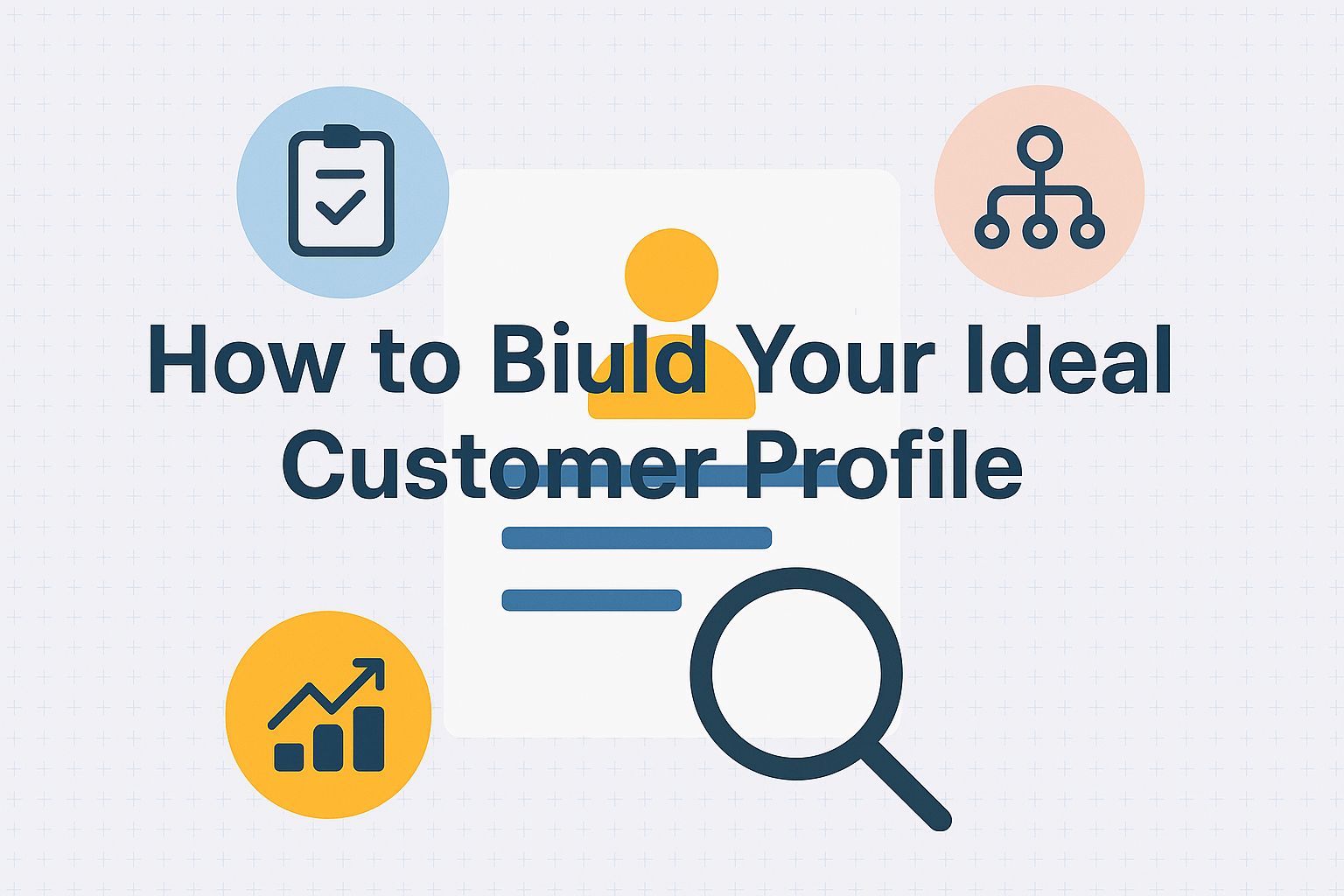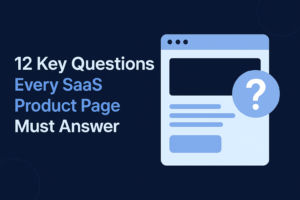In the world of B2B SaaS, growth doesn’t come from how many leads you attract, it comes from how many of them are the right fit. Too often, companies invest heavily in ads, content, and outreach, only to find that a large part of their pipeline is filled with accounts that never convert or don’t stick around long enough to make a real impact. The root cause of this problem usually comes down to one missing piece: a clear and well-defined Ideal Customer Profile (ICP).
An ICP is not just a description of who might be interested in your product. It is a carefully constructed blueprint of the companies most likely to see value, convert quickly, expand over time, and stay loyal. For a SaaS business built on recurring revenue, defining the right ICP can mean the difference between sustainable growth and a leaky funnel. In this article, we’ll break down how to build an ICP specifically for B2B SaaS products, explain what elements matter most, walk through the process step by step, and highlight common mistakes to avoid. By the end, you’ll not only understand the theory but also have a clear framework you can apply to your own business.
What Exactly Is an Ideal Customer Profile?
At its core, an ICP is a detailed description of the type of company that is the best possible fit for your SaaS product. It usually includes firmographic attributes like industry, size, and revenue; technographic details like what software stack they already use; and behavioral patterns that indicate readiness to buy. Think of it as a composite sketch of your highest-value customers.
It’s worth noting how an ICP differs from a buyer persona. A persona focuses on individuals the job titles, responsibilities, and motivations of the people who make or influence decisions. An ICP, by contrast, looks at the company as a whole. In SaaS, both are important, but the ICP usually comes first because it sets the boundaries of which companies you should be targeting in the first place.
The Core Components of a SaaS ICP
Building a SaaS ICP involves more than demographic checkboxes. The recurring nature of the model and the complexity of buying committees make it multi-dimensional. A strong SaaS ICP typically covers the following:
-
Firmographics – These are the traditional business attributes: company size, employee count, revenue, geography, and industry. A SaaS tool aimed at enterprise finance teams will have a very different ICP than one targeting early-stage startups.
-
Technographics – SaaS adoption often depends on what systems are already in place. If your product integrates with Salesforce, your ICP should prioritize companies that already use Salesforce or similar CRMs.
-
Business Needs and Challenges – Beyond numbers, what problems is the company trying to solve? A payroll SaaS tool, for example, might find its best ICP in fast-growing companies that struggle with compliance as they scale.
-
Buying Committee – In SaaS, the buyer and the user are rarely the same person. Your ICP should capture both—the executives who approve budgets and the managers or team members who will rely on the product daily.
-
Behavioral Triggers – Events such as raising a funding round, undergoing a compliance audit, or expanding into a new region can indicate when a company is primed to purchase.
-
Economic Fit – SaaS companies must also consider LTV and CAC. If a segment consistently churns before recouping acquisition costs, it should not remain in your ICP even if it seems like a good “fit” on paper.
Taken together, these elements create a holistic picture that goes beyond vague categories like “mid-market companies” or “technology sector” and gives your team a laser-focused understanding of who truly drives value.
A Step-by-Step Process to Build Your ICP
So how do you move from abstract concepts to a working ICP you can use in campaigns and sales calls? The process is both analytical and iterative.
Step 1: Audit Your Best Customers
The easiest way to start is to look at your existing customer base. Identify your top accounts based on lifetime value, retention, product adoption, and expansion revenue. Patterns often emerge quickly. You might find, for instance, that your most successful customers are all mid-sized SaaS companies in North America that use HubSpot and Salesforce.
Step 2: Add Qualitative Insights
Numbers alone don’t tell the full story. Speak with your sales team to learn which prospects close most smoothly, and with your customer success team to uncover which clients need the least support. These frontline insights help explain the “why” behind the patterns.
Step 3: Define Firmographic and Technographic Boundaries
Now begin narrowing down the attributes. Instead of “technology companies,” get specific: “SaaS businesses with 200–500 employees, based in the US or UK, using Salesforce and Slack.” This precision avoids the trap of chasing any company that seems vaguely relevant.
Step 4: Map Decision-Makers and Users
For SaaS, identifying the roles within the buying committee is essential. Who signs off on the purchase? Who evaluates the tool? Who actually uses it? In an HR software example, the CHRO might own the budget, the HR manager evaluates functionality, and employees interact with the tool daily. A strong ICP makes these distinctions clear.
Step 5: Validate with Data
Don’t stop at assumptions. Test your ICP through targeted LinkedIn campaigns, outbound email, or ABM pilots. Measure metrics such as conversion rates, time-to-close, and renewal percentages. If results differ significantly from your expectations, refine accordingly.
Step 6: Document and Share
Once validated, put your ICP into a format everyone can use—a one-page reference that sales can qualify against, marketing can build campaigns around, and product can align with. The more visible and practical the ICP is, the more likely it will actually shape company behavior.
Step 7: Iterate Over Time
An ICP is not a “set it and forget it” exercise. As your SaaS evolves, new use cases may emerge, markets may shift, and your best-fit customers may change. Review and adjust your ICP at least once every six months, or whenever you release major product updates or expand into new regions.
Common Mistakes to Avoid
While the process may sound straightforward, many SaaS businesses trip up when building their ICP. One common mistake is being too broad. Targeting “all mid-market companies” is not an ICP; it’s a recipe for wasted ad spend. Another pitfall is building an aspirational ICP based on the type of customers you wish to have rather than those who actually succeed with your product. This often leads to chasing enterprise clients before your product is ready, resulting in long sales cycles and failed implementations.
Ignoring churn data is another error. A segment might sign deals quickly but consistently cancel within a year. Including them in your ICP would drain resources rather than drive growth. Finally, some companies confuse buyer personas with ICP and end up with a list of individual roles without clarity on what type of company they belong to. Keeping the distinction clear helps prevent misalignment.
An Example ICP for a SaaS Product
To make this concrete, here’s what a filled-out ICP might look like for a fictional HR Tech SaaS company:
-
Industry: B2B SaaS and HR Tech
-
Company Size: 200–500 employees
-
Geography: North America and UK
-
Tech Stack: Salesforce CRM, HubSpot Marketing Hub, Slack
-
Pain Points: Scaling HR operations, compliance management, onboarding efficiency
-
Decision-Maker: VP of HR or CHRO, with CFO as budget owner
-
Typical Deal Size: $40K+ ARR
-
Trigger Events: Raised Series B funding, hiring 50+ employees in the last six months
This level of detail makes it clear which companies to prioritize, what messages to emphasize, and which events signal a high likelihood of conversion.
Tools and Templates to Simplify the Process
While building an ICP can be done manually, using the right tools accelerates the process. Data enrichment platforms like Clearbit and ZoomInfo help verify firmographics and technographics. LinkedIn Sales Navigator is excellent for identifying company attributes and trigger events. For surveys and qualitative insights, tools like Typeform or HubSpot forms are useful.
Documenting your ICP in a shared workspace such as Notion, Airtable, or a Google Doc ensures that all teams can access and use it. You can also create a simple one-page PDF card that highlights the most critical attributes and distribute it to sales and marketing.
How to Put Your ICP Into Action
Defining your ICP is only valuable if you apply it. In marketing, use it to refine targeting in ad campaigns, choose the right content topics, and craft messaging that speaks directly to your best-fit accounts. In sales, use it as a qualification filter, if a prospect falls outside the ICP, they should not consume the same resources as a high-fit lead. In product, let the ICP guide feature prioritization; build for the customers most likely to stick around and expand. And in customer success, tailor onboarding and support resources to the needs of your ICP, creating playbooks that match their workflows and challenges.
Build for the Right Audience, Not the Largest One
An Ideal Customer Profile is more than a marketing exercise it’s a business lens that sharpens everything you do. When you understand exactly which companies gain the most from your product, every department starts to operate with intent. Marketing attracts qualified leads instead of noise. Sales focuses on accounts that actually close. Product teams design for real users, not assumptions.
Creating an ICP takes time. It means examining your customer data, studying usage behavior, and having honest conversations with your teams about who truly benefits from your solution. But once you’ve done it, you stop chasing volume and start building predictable, profitable growth.
In SaaS, clarity beats speed. When your ICP is clear, you don’t just scale you scale in the right direction.
FAQ: Building the Ideal Customer Profile (ICP) for B2B SaaS
1. What is the difference between an ICP and a buyer persona?
An ICP (Ideal Customer Profile) describes the company-level traits of your best customers — their size, industry, tech stack, revenue, etc. A buyer persona, on the other hand, is a semi-fictional individual within those companies — their title, motivations, challenges, decision-making process, and personal behaviors. Both are important. ICP guides which accounts to pursue, while personas guide how to message and engage the right people in those accounts.
2. What attributes should I include in a SaaS ICP?
Your ICP should be multi-dimensional. At a minimum, it should include:
-
Firmographic traits (industry, company size, revenue band, geography)
-
Technographic stack (what software / platforms they already use)
-
Business challenges & objectives (pain points your product solves)
-
Triggering events or signals (growth events, transformations, funding)
-
Role mapping (who within that company will buy, champion, use)
-
Economic fit (ACV, LTV, ability to scale)
3. How do I validate an ICP once I’ve drafted it?
You can validate by:
-
Running small pilot outreach or ABM campaigns targeting accounts that match your ICP and measuring conversion, response, and retention rates
-
Comparing new accounts’ behavior against your current best customers
-
Using analytics or enrichment tools (CRM data, third-party data providers) to see whether those firms behave similarly
-
Refining based on feedback from sales, customer success, and product teams
4. How often should I revisit or update my ICP?
Your ICP should not be static. Markets change, product offerings evolve, and ideal customers shift with business maturity. It’s wise to review and refresh your ICP at least twice a year, or whenever you launch new features, expand into new geographies, or notice key metrics (conversion, churn) are deteriorating.
5. What are some common mistakes when defining a SaaS ICP?
-
Being too broad (e.g. “all mid-market tech companies”)
-
Using aspiration rather than reality (defining an ICP you hope to win rather than one you have proof works)
-
Ignoring churn / retention data (a segment that signs fast but churns is a false fit)
-
Equating buyer personas with ICPs (mixing up account and individual levels)
-
Not validating assumptions with data or tests
-
Letting ICP sit unused (i.e. not embedding it into marketing, product, and sales motions)
6. Can one SaaS product have multiple ICPs?
Yes — especially as your product grows or diversifies. You may start with a narrow “core ICP” in early stages, then expand to secondary profiles to explore new verticals or use cases. But each ICP should be distinct and well-understood, with clear messaging, qualification rules, and prioritization. Don’t blur too many in one bucket.

vetrivel is an accomplished SEO and digital marketing expert with 5 plus years of experience. dedicated to providing readers with informative and engaging content.




